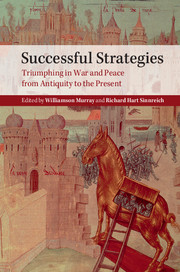Book contents
- Frontmatter
- Dedication
- Contents
- List of tables and map
- List of contributors
- Acknowledgments
- Introduction
- 1 The strategic thought of Themistocles
- 2 The grand strategy of the Roman Empire
- 3 Giraldus Cambrensis, Edward I, and the conquest of Wales
- 4 Creating the British way of war: English strategy in the War of the Spanish Succession
- 5 Failed, broken, or galvanized?
- 6 Victory by trial and error: Britain’s struggle against Napoleon
- 7 The strategy of Lincoln and Grant
- 8 Bismarckian strategic policy, 1871–1890
- 9 Dowding and the British strategy of air defense 1936–1940
- 10 US naval strategy and Japan
- 11 US grand strategy in the Second World War
- 12 American grand strategy and the unfolding of the Cold War 1945–1961
- 13 The Reagan administration’s strategy toward the Soviet Union
- Afterword
- Index
- References
7 - The strategy of Lincoln and Grant
Published online by Cambridge University Press: 05 June 2014
- Frontmatter
- Dedication
- Contents
- List of tables and map
- List of contributors
- Acknowledgments
- Introduction
- 1 The strategic thought of Themistocles
- 2 The grand strategy of the Roman Empire
- 3 Giraldus Cambrensis, Edward I, and the conquest of Wales
- 4 Creating the British way of war: English strategy in the War of the Spanish Succession
- 5 Failed, broken, or galvanized?
- 6 Victory by trial and error: Britain’s struggle against Napoleon
- 7 The strategy of Lincoln and Grant
- 8 Bismarckian strategic policy, 1871–1890
- 9 Dowding and the British strategy of air defense 1936–1940
- 10 US naval strategy and Japan
- 11 US grand strategy in the Second World War
- 12 American grand strategy and the unfolding of the Cold War 1945–1961
- 13 The Reagan administration’s strategy toward the Soviet Union
- Afterword
- Index
- References
Summary
Abraham Lincoln’s primary grand strategic aim during the Civil War, to preserve the Union, contained within itself a deceptive simplicity. On the one hand, it meant preserving the Federal Union of 1860 and the results of the 1860 presidential election, which had elected a Republican Party committed not to abolishing slavery, but to restricting it to the states where it existed. On the other hand, the outbreak of war in 1861 raised questions within the states loyal to the Union as to whether or not the Republican Party’s antebellum goals could provide a lasting political and military solution to the rebellion. Some Republicans hoped to strike at what they saw as the root cause of Confederate treason – a social system dominated by slaveholding planters – with punitive measures most would have disavowed during the 1860 election, while many Democrats and even some conservative Republicans feared the consequences of harsh measures for both domestic liberty in the free soil states and the prospects of long-term reunion.
Lincoln eventually determined that only “hard war” measures could break Confederate resistance, but he had to manage a divided Northern public opinion even as his own views evolved. In 1864, in accordance with his commander-in-chief’s political ends, Ulysses Grant selected a military strategy of coordinated and simultaneous military movements against Confederate military power that had the virtues of simplicity and inherent flexibility. Grant adapted his military methods to Lincoln’s need to manage his political coalition, even when it required overriding Grant’s own professional preferences as to military priorities and personnel. Above all, Lincoln had to prevent political support for the war from collapsing under the stress of increasing losses in blood and treasure, even when the North’s political system’s own misplaced priorities helped bring about the very losses that came so close to demoralizing it.
- Type
- Chapter
- Information
- Successful StrategiesTriumphing in War and Peace from Antiquity to the Present, pp. 189 - 213Publisher: Cambridge University PressPrint publication year: 2014



